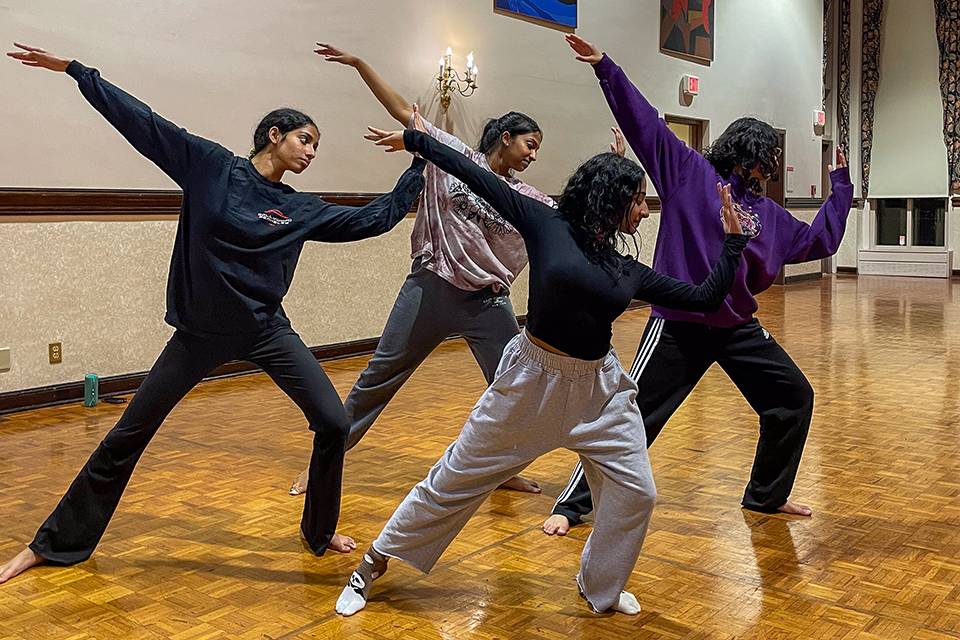What Do You Feel?
A Conceptual Dance Project by Samanvita Kasthuri, Dance Minor (A&S '24)
On my flight to Bangalore in December of 2023, I was reading a research article that was qualitatively assessing how people perceive and connect to watching dance. The sample of viewers were required to watch dance videos and note down their observations — one of which was a bharatanatyam performance. I was immediately drawn to this research due to the inclusion of an Indian classical dance style, as I had never seen any academic research about it.
Many of the participants stated their inability to move like the dancers they saw, expressing awe and shock at the ease at which dancers are able to manipulate their bodies. However, When it came to reflecting on the bharatanatyam performance, there was awe still expressed about the bodily movements, but there was one stark difference that made bharatanatyam distinct — storytelling. A flip, or a leap, or a split, shocked the sample watching a ballet performance. But a twitch of an eyebrow, the widening of the eyes, or a tear slipping down the dancer's face, were all aspects of “abhinaya” that moved the viewers of the bharatanatyam performance. What is it about storytelling in Indian classical dance that is so captivating?
This article inspired me to think about the nature of storytelling in dance, and how that differs from style to style. To me, every dance has a story to tell, no matter how obvious or subtle you make it. The choreographer always has an intention behind a piece that they craft to present on stage, and different styles of movement help encourage the execution of that theme, story, idea, concept, etc. However, I specifically was curious about the intricacies of the way you execute storytelling in bharatanatyam — the concept of “abhinaya” as it is in bharatanatyam does not exist in the Western world. How can I introduce “abhinaya” in ballet? What about contemporary? What about hip-hop?
The choreography in “What Do You Feel?” seeks to introduce a storyline through four dances, all categorized between emotion or energy. There are four categories — High Energy + Low Emotion; Lower Energy + Higher Emotion; Lowest Energy + Highest Emotion; Highest Energy + Highest Emotion. Different pairings result in different ways a storyline could be executed using “abhinaya” techniques. For example, a category with a higher level of energy but a lower level of emotion would be executed mainly through movement and body language, relying less on the “abhinaya” technique of telling a story. Each category is paired with a specific dance style. High Energy + Low Emotion is Hip Hop; Lower Energy + Higher Emotion is Contemporary; Lowest Energy + Highest Emotion is Bharatanatyam; and Highest Energy + Highest Emotion is the combination of all the previous styles, and is the most experimental in terms of style. The challenge is to stay true to the dance style while implementing the idea of “abhinaya”.
I had numerous goals while creating this project. One of my main focuses was to draw attention to “abhinaya”, specifically in the dance style of bharatanatyam. Oddly enough, this was a part of dance that I had normally steered away from, as it made me highly uncomfortable for most of my life. To me, “abhinaya” is the most vulnerable part of Indian classical dancing — you must be brave enough to pour your entire heart out on the stage and to the audience, as your biggest and most important responsibility is to tell the story. Another focus of mine was to create a project that would cross between dance styles and cultures. I had planned out this project with the intention of collaborating with other dance groups on campus, as well as dance minors who are involved in the Theater and Dance Program. I hope that projects like “What Do You Feel?” can inspire more collaborative work between the groups on campus, and we can continue to highlight the immense talent that is growing here at Saint Louis University.
“What Do You Feel?” is a work that plays with differences in dance styles, musical genres, and interdisciplinary fields. Yet through these differences, there are similarities. Whether you’ve been trained in bharatanatyam or ballet, or you dance hip-hop instead of contemporary, the essence of dance is what pulls everyone together. I’ve experienced sheer joy working on this project with the dancers from Phases of Motion, SLU Shakti, and the singers from Soorya Performing Arts.
I would like to thank the Honors’ Department for awarding me with the Investigative Learning Experience (ILEX) Award to cover funding expenses associated with this project. Additionally, I would like to thank Holly Seitz for guiding me through this entire process — her support for my vision has been unwavering, and I am so grateful that she’s been by my side as a guide for this project, but also as my mentor for all my four years as a dance minor.
